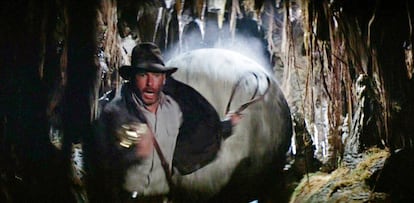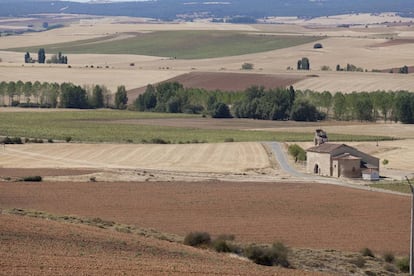What real archaeologists think of Indiana Jones
Experts complain that Spielberg’s saga shows them as ‘treasure hunters’ and that the main character destroys sites to get hold of a magical object


In Raiders of the Lost Ark (1981), the first of the films that make up the Indiana Jones saga, U.S. government agents order the protagonist — a professor of archaeology named Indiana Jones (‘Indy’ to his friends) — to find the Ark of the Covenant, an impressive golden chest containing the Tablets of the Law that God gave to Moses and bring it back to the United States. But the Nazis are already ahead in their excavations and could make use of the ark’s apocalyptic destructive power at any time. World War II is about to break out. In 1939, Francisco Franco’s government agreed with Adolf Hitler’s government — this is real, not fiction — to open the Visigoth necropolis of Castiltierra (Segovia) to demonstrate the Aryan origin that supposedly united both nations. All encouraged by the Falange [fascist party] and the connivance of the General Secretary of Excavations, Julio Martínez-Santa Olalla. More than 400 tombs were opened and their rich trousseaux were plundered and sent to Germany by diplomatic pouch. In Steven Spielberg’s film, the ark ends up in the warehouses of Area 51, a secret military base in Nevada. In the case of Castiltierra, most of the Visigothic funerary elements have been kept at the Germanisches Nationalmuseum in Nuremberg and have never been returned.
Archaeologist Esperanza Martín (site director of Flavia Augusta and Lucus Asturum, among others) gives talks in schools on the importance of protecting heritage. Just before the release of James Mangold’s Indiana Jones and the Dial of Destiny, (the fifth and final part of the saga) this Wednesday, the expert considers that “the Indy movies have good and bad aspects.” The protagonist [Harrison Ford] is a cultured and educated person, but he is also a born destroyer. Someone who destroys archaeological sites to find mythical treasure.” The specialist believes that these Hollywood films portray professionals as “people who are adventurers, continuously struggling, out of touch with reality, and, most dangerously, treasure hunters who are capable of destroying everything in order to achieve their goal.”
For Martín, however, “much worse is Tadeo Jones [a children’s animated movie], where the main character has no scientific training whatsoever [in the film he says he works as a bricklayer], which makes it seem like anyone can be an archaeologist.” In addition, the expert continues, “Tadeo is accompanied by a young woman who is smarter than him, but who is mocked by other characters because she is a woman, despite being highly qualified. Is that the message we want to send to our children?”
Jordi Serrallonga is a collaborating professor of Prehistory, Anthropology and Human Evolution at the Open University of Catalonia, a job he combines with research in Africa, America, Oceania and Asia. He has just published Un arqueólogo nómada en busca del Dr. Jones (only available in Spanish), a book in which he shows his admiration for the well-known American movie and recalls the happy memories of his childhood when he saw it for the first time. “I put on my fedora [the type of hat worn by Indiana] and any jungle, desert, savanna, mountain or ocean becomes the setting for a story where the memory of Jones — and not his buff physique — accompanies me at all times. It’s easy. Although in the real world there has never been a treasure hunter who answers to the nickname of Indy or Indiana, Dr. Jones is an avatar that feeds on what archaeology was, is and will be.”
Manuel Rojo Guerra, professor of Prehistory at the University of Valladolid, admits that he gave one of his collaborators in the spectacular research they do in El Pendón (Burgos) “an Indy hat and a whip for her birthday.” “She loves the Spielberg saga, and we had a few laughs. But my opinion about this kind of film is not positive, as they do not reflect the reality of archaeology. It’s a cinematic adventure that uses archaeology as an excuse,” he says. “Some students may have become interested in our discipline after seeing Indiana, but archaeology is hard, serious, laboratory work. It’s nothing like the films.” Like his colleagues, Rojo maintains that “in this work, not everything goes towards achieving an end. We work with respect, [use] proper methodology to reach scientific conclusions, and we don’t blow up buildings to find a secret door.”

Vicente Lull, director of the La Almoloya-La Bastida excavation project, latest Fundación Palarq archaeology prize winner and professor of Prehistory at the Autonomous University of Barcelona, maintains that “Indiana Jones has contributed to the popularity of archaeology, without a doubt, but at the same time he has trivialized it. The idea of an adventurous, heteropatriarchal, attractive, and seductive male protagonist has convinced many people to throw themselves into a beautiful but moribund profession by adopting a self-serving generic. There is scant public investment in researching and safeguarding a collective social inheritance that, curiously enough, is called heritage.”
In Spain, the average investment for an excavation is around €18,000 ($19,732). Most archaeological teams, including professors, usually take advantage of their summer vacation days to excavate, employ interns or recent graduates for research work. They spend the limited subsidies received from public administrations, universities and private foundations on the young people’s board and lodging, hiring laborers for the hardest tasks, and to pay for laboratory work. Nothing like Spielberg’s intrepid professor, who travels the world alone and has no financial troubles.

Lull believes, however, that the “daughter culture of comics and tourism has a friendly face that generates benefits, and we should take advantage of them.” “I think the greatest virtue of Jones’s impact on archaeology lies in the fact that we have traded the colonialist’s pith helmet for the brown fedora, which burns your head so much that you imagine you’re in the era that you’re excavating. And then, you see yourself with the whip in your hands, and you wonder what you are doing and for whom,” he notes.
Esperanza Martín explains, “The worst thing about Indiana Jones is that the mythical Ark of the Covenant ends up in a warehouse on a military base in the United States without anyone being able to admire it, instead of a museum, which is where it should be.” Although the Visigothic treasure of Castiltierra is located in a museum, it is in Nuremberg, 1,844 kilometers from it was stolen.
Sign up for our weekly newsletter to get more English-language news coverage from EL PAÍS USA Edition
Tu suscripción se está usando en otro dispositivo
¿Quieres añadir otro usuario a tu suscripción?
Si continúas leyendo en este dispositivo, no se podrá leer en el otro.
FlechaTu suscripción se está usando en otro dispositivo y solo puedes acceder a EL PAÍS desde un dispositivo a la vez.
Si quieres compartir tu cuenta, cambia tu suscripción a la modalidad Premium, así podrás añadir otro usuario. Cada uno accederá con su propia cuenta de email, lo que os permitirá personalizar vuestra experiencia en EL PAÍS.
¿Tienes una suscripción de empresa? Accede aquí para contratar más cuentas.
En el caso de no saber quién está usando tu cuenta, te recomendamos cambiar tu contraseña aquí.
Si decides continuar compartiendo tu cuenta, este mensaje se mostrará en tu dispositivo y en el de la otra persona que está usando tu cuenta de forma indefinida, afectando a tu experiencia de lectura. Puedes consultar aquí los términos y condiciones de la suscripción digital.
More information
Archived In
Últimas noticias
Most viewed
- Sinaloa Cartel war is taking its toll on Los Chapitos
- Oona Chaplin: ‘I told James Cameron that I was living in a treehouse and starting a permaculture project with a friend’
- Reinhard Genzel, Nobel laureate in physics: ‘One-minute videos will never give you the truth’
- Why the price of coffee has skyrocketed: from Brazilian plantations to specialty coffee houses
- Silver prices are going crazy: This is what’s fueling the rally








































